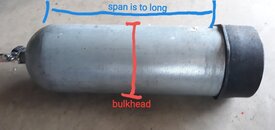In the old days (mid 1960 & 70s), most saturation and deep-bounce diving bells were rated for internal and external pressure. I was always MUCH more nervous on one atmosphere/external pressure dives.
The idea was that divers could inspect the worksite at one atmosphere, get geared up, and do a rapid blow down (pressurize) to working depth. ROVs have eliminated that need and saturation has displaced deep mixed gas bounce dives.
The idea was that divers could inspect the worksite at one atmosphere, get geared up, and do a rapid blow down (pressurize) to working depth. ROVs have eliminated that need and saturation has displaced deep mixed gas bounce dives.




